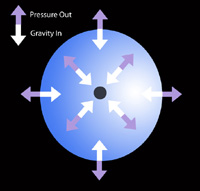There is strong evidence for two types of black holes: stellar black holes with masses of a dozen or so Suns, and supermassive black holes with masses of many millions of Suns. Stellar black holes are formed as a natural consequence of the evolution of massive stars. The origin of supermassive black holes is a mystery. They are found only in the centers of galaxies. It is not known whether they formed in the initial collapse of the gas cloud that formed the galaxy, or from the gradual growth of a stellar mass black hole, or from the merger of a centrally located cluster of black holes, or by some other mechanism.

Radiation Pressure Schematic
When matter is pulled toward a black hole, it is heated and produces X-rays. These X-rays create a radiation pressure which pushes out on the matter. If the matter continues to fall in,the radiation pressure of the X-rays must be less than the pull of the black hole's gravity. This effect, called the Eddington limit, enables astronomers to estimate the mass of a black hole.
The mass of a stellar black hole can be deduced by observing the orbital acceleration of a star as it orbits its unseen companion. Likewise, the mass of a supermassive black hole can be determined by using the orbital acceleration of gas clouds swirling around the central black hole. When orbital acceleration cannot be used to establish the mass of a black hole, astronomers can place a lower limit on its mass by measuring the X-ray luminosity due to matter falling into a black hole. The pressure of the outflowing X-rays must be less than the pull of the black hole's gravity on the inflowing matter.
This technique was used to estimate the mass of a black hole discovered in a dense star cluster about 600 light years from the center of the galaxy M82. Astronomers found that the mass of the black hole must be greater than 500 Suns. This is much more massive than known stellar black holes, and much smaller than supermassive black holes, so it is called a "mid-mass" black hole.
Astrophysicists had come to believe that galactic centers were the only places where conditions were right for the formation and growth of large or very large black holes. The discovery of a large, mid-mass black hole located away from the galaxy's center, shows that somehow large black holes can also form in dense star clusters. Current possible explanations for the formation of mid-mass black holes include the mergers of scores of stellar black holes, or the collapse of a superstar. Another possibility is that the X-rays produced by infall into the black hole are beamed toward the Earth. This would reduce the overall output of X-rays from the source, and reduce the mass needed to overcome the pressure of the outflowing X-rays to a value consistent with stellar mass black holes.




